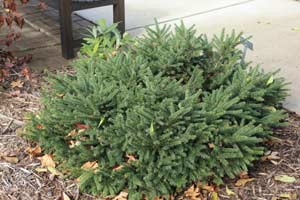Spruce Dwarf types – Pruning, Winter Care and Fertilizing
 These evergreens require little or no pruning, but some pruning can be done if desired. If whole branches need to be removed, this should be done in early spring, before any new growth begins. Light shearing can be done when the new growth is 3/4 of its full size.
These evergreens require little or no pruning, but some pruning can be done if desired. If whole branches need to be removed, this should be done in early spring, before any new growth begins. Light shearing can be done when the new growth is 3/4 of its full size.
Young shrubs respond very well to fertilizing. Either granular, liquid or stake type fertilizers can be used. Granular fertilizers can be worked into the soil around the plant at a rate of 2 lbs or 2 pints per 100 square feet of planting bed. An alternative way to apply granular fertilizers starts with drilling or punching 6” deep holes at the drip line of the tree. Poured into these holes should be a total of 2 pounds of fertilizer per 1″ of trunk diameter (divided up and poured evenly between all of the holes). These holes should not be filled with more than 1/3 of the fertilizer and then they should be top filled with soil. This method of fertilization should only be done once a year, and is best done in late fall, or in early spring before bud break. Multi Purpose 10-10-10 Fertilizer works well.
Liquid fertilizers (such as Miracle Gro) are mixed with water and applied the same as you would water the plant (see product for specific details). This should be done three or four times per year starting in late April and ending in mid July. Stake type fertilizers can be used following the directions on the package. With any of the above techniques, a balanced mixture should be used; 20-20-20 or similar mix is a good choices. Organic fertilizers, like manure, can also be used with good results. The material should be worked into open soil at a rate of one bushel per 6’ of shrub or 100 square feet of bed area. As a tree matures, less fertilizing will be needed.
These evergreens are susceptible to mouse damage over winter. Specifically, these mice will eat the bark off the stem of the plant harming it and in many cases, killing the plant. To control this, a product such as Bait Station should be set out under the evergreen in late fall. To reduce the rodent population, use a product that contains Zinc Phosphide. Care should be taken when using any pesticide or poison. Watering in late fall is very important for the winter health of any evergreen and should be done to young plants every year in early November. Even more mature plants can benefit from late season waterings, especially after a dry fall season.
